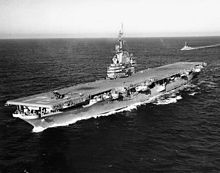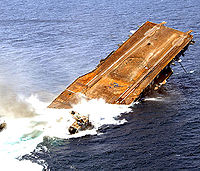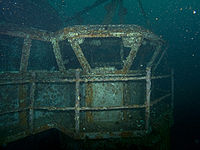|
CV-34 Philip J. Arent Seaman, U.S. Navy 1951-1954 History in Words and Photos
|
||||||||
|
THORNTON GENEALOGY PROJECT 2011 |
||||||||
|
USS
Oriskany (CV/CVA-34)
– nicknamed Mighty O, and occasionally referred to as the
O-boat – was one of 24 Essex-class
aircraft
carriers completed during or shortly after World War II for the
United States Navy. The ship was the third US Navy ship to bear the
name, and was named for the Revolutionary
War Battle
of Oriskany. The
history of Oriskany differs considerably from that of her
sister ships. Originally designed as a "long-hulled" Essex-class
ship (considered by some authorities to be a separate class, the Ticonderoga
class) her construction was suspended in 1947. She eventually was
commissioned in 1950 after conversion to an updated design called SCB-27
("27-Charlie"), which became the template for modernization
of 14 other Essex-class
ships. She
operated primarily in the Pacific into the 1970s, earning two battle
stars for service in the Korean War, and five for service in the
Vietnam War. In 1966 one of the worst shipboard fires since World War
II broke out on Oriskany when a magnesium flare was
accidentally ignited; forty-four men died in the fire. Oriskany's
post-service history also differs considerably from that of her sister
ships. Decommissioned in 1976, she was sold for scrap in 1995, but was
repossessed in 1997 because nothing was being done (lack of progress).
In 2004 it was decided to sink her as an artificial reef off the coast
of Florida in the Gulf of Mexico. After much environmental review and
remediation to remove toxic substances, she was carefully sunk in May
2006, settling in an upright position at a depth accessible to
recreational divers. As of 2008 the Oriskany is "the
largest vessel ever sunk to make a reef".[1] Construction
and Commissioning The
name "Oriskany" was originally assigned to CV-18,
but that hull was renamed Wasp
when the keel was laid in 1942. CV-34 was laid down on 1 May
1944 by the New
York Naval Shipyard, launched on 13 October 1945, and sponsored by
Mrs. Clarence Cannon. Construction was suspended on 12 August 1947,
when the ship was approximately 85% complete. Oriskany was
redesigned as the prototype for the SCB-27
modernization program. To handle the new generation of carrier
aircraft, the flight deck structure was massively reinforced. Stronger
elevators, more powerful hydraulic catapults, and new arresting gear
were installed. The island structure was rebuilt, the anti-aircraft
turrets were removed, and blisters were added to the hull. Blistering
the hull (also known as adding bulges) increases the cross-sectional
area of a ship's hull, thereby increasing its buoyancy and stability.
It also provides increased bunker volume. In the case of the Oriskany,
this would have been for aviation fuel. These features would have been
crucial to a ship that had so much topside weight added after its
original design. Oriskany was commissioned in the New York
Naval Shipyard on 25 September 1950, Captain Percy H. Lyon in command. Service
history 1950–1956 Oriskany
departed New York on 6 December 1950, for carrier qualification
operations off Jacksonville, Florida, followed by a Christmas call at
Newport, Rhode Island. She resumed operations off Jacksonville through
11 January 1951, when she embarked Carrier
Air Group 1 for shakedown out of Guantanamo Bay, Cuba. After
major modifications at New York Naval Shipyard from 6 March to 2
April, she embarked Carrier
Air Group 4 for training off Jacksonville, then departed Newport
on 15 May 1951, for Mediterranean deployment with the 6th
Fleet. Having
swept from ports of Italy and France to those of Greece and Turkey,
from there to the shores of Tripoli, Oriskany returned to
Quonset Point, Rhode Island on 4 October 1951. She entered Gravesend
Bay, New York on 6 November 1951 to offload ammunition and to have her
masts removed to allow passage under the East River Bridges to the New
York Naval Shipyard. Overhaul included the installation of a new
flight deck, steering system, and bridge. Work was complete by 15 May
1952, and the carrier steamed the next day to take on ammunition at
Norfolk, Virginia from 19–22 May. She then got underway to join the
Pacific Fleet, steaming via Guantanamo Bay, Rio de Janeiro, Cape Horn,
Valparaíso, and Lima, arriving San Diego, California on 21 July. Following
carrier qualifications for Air
Group 102, Oriskany departed San Diego on 15 September
1952, to aid United
Nations forces in Korea.
She arrived Yokosuka
on 17 October and joined Task
Force 77 off the Korean Coast on 31 October. Her aircraft struck
hard with bombing and strafing attacks against enemy supply lines and
coordinated bombing missions with surface gunstrikes along the coast.
Her pilots downed two Soviet-built
MiG-15
jets and damaged a third on 18 November.[2] Strikes
continued through 11 February, attacking enemy artillery positions,
troop emplacements, and supply dumps along the main battlefront.
Following a brief upkeep period in Japan,
Oriskany returned to combat on 1 March 1953. She continued in
action until 29 March, called at Hong
Kong, then resumed air strikes on 8 April. She departed the Korean
Coast on 22 April, touched at Yokosuka, and then departed for San
Diego on 2 May, arriving there on 18 May. Following
readiness training along the California coast, Oriskany
departed San Francisco on 14 September to aid the 7th
Fleet watching over the uneasy truce in Korea, arriving in
Yokosuka on 15 October. Thereafter, she cruised the Sea of Japan, the
East China Sea, and the area of the Philippines. After providing air
support for Marine amphibious assault exercises at Iwo Jima, the
carrier returned to San Diego on 22 April 1954. She entered San
Francisco Naval Shipyard for overhaul; the overhaul was completed on
22 October, when she put to sea for the first of a series of coastal
operations, and participation in the production of the Korean War-era
film The
Bridges at Toko-Ri, where she stood in for the escort carrier USS
Savo Island.[3] Oriskany
arrived at Yokosuka on 2 April 1955, and operated with the Fast
Carrier Task Force ranging from Japan and Okinawa to the Philippines.
This deployment ended on 7 September, and the carrier arrived NAS
Alameda, California, on 21 September. She
cruised the California Coast while qualifying pilots of Air Group 9,
then put to sea from Alameda on 11 February 1956 for another rigorous
Western Pacific (WestPac) deployment. On
26 October 1967, then–Lieutenant Commander John
McCain flew off Oriskany in an A-4 Skyhawk on his 23rd
bombing mission of the Vietnam War. He was shot down that day and was
a prisoner of war until January 1973. Oriskany
received two battle
stars for Korean War service and ten for Vietnam War service. Oriskany
was sold for scrap by the Defense Reutilization and Marketing Service
on 9 September 1995 to Pegasus International, a start-up company at
the former Mare Island Naval Shipyard in Vallejo, CA. The contractor
towed the ship from Bremerton to Vallejo, but the contract was
terminated for default on 30 July 1997, because of lack of progress.
While berthed at Mare Island in rusted and decrepit condition, she was
used as a setting for the Robin Williams film, What Dreams May Come
(1998) as part of the representation of Hell. The
Navy took back possession of the ship and after a few more years at
the former Mare Island Navy Yard, she was towed in 1999 to the
Maritime Administration's Beaumont Reserve Fleet in Beaumont, Texas,
for storage pending availability of funding for her disposal. 2004
– artificial reef The
Navy announced on 5 April 2004, that it would transfer the former
aircraft carrier to the State of Florida for use as an artificial
reef. In September 2003 the Navy awarded a contract to Resolve Marine
Group/ESCO Marine Joint Venture for the environmental remediation work
necessary for sinking the ship as an artificial reef. The contractor
towed the ship to Corpus Christi, TX in January 2004 and completed the
environmental preparation work in December 2004. Oriskany
was the first United States warship slated to become an artificial
reef, under authority granted by the fiscal 2004 National Defense
Authorization Act (Public Law 108-136). Oriskany was towed to
Pensacola in December 2004 and was originally scheduled to be sunk
with controlled charges 24 mi (39 km) south of Pensacola by June 2005.
Exhaustive ecological and human health studies were conducted by Navy
scientists in consultation with the Environmental Protection Agency
(EPA) to demonstrate no adverse impact from reefing the ship. Failure
to gain EPA approval caused a delay, so Oriskany was then towed
back to Texas in June to ride out the 2005 hurricane season.[10]
Completion and peer review of a complex Prospective Risk Assessment
Model developed in consultation with EPA, the first for any ship
reefing project, was necessary to support EPA's February 2006 decision
to issue a risk-based PCB disposal approval for the estimated 750 lb
(340 kg) of polychlorinated biphenyls contained in solid form, mostly
integral in the insulation layers of the electrical cabling throughout
the ship. Based
on EPA's approval, after a public comment period, the ship was towed
to Pensacola, FL in March 2006 for final preparations for sinking
under a Navy contract. A team of Navy personnel accomplished the
sinking of the ship on 17 May 2006, supported by the Florida Fish and
Wildlife Conservation Commission, Escambia County Department of
Natural Resources, the U.S. Coast Guard, the Pensacola Police
Department, and several sheriff departments of Escambia County and
surrounding counties. A Navy Explosive Ordnance Disposal team from
Panama City, FL detonated C-4 explosive charges of approximately 500
lb (230 kg) net explosive weight, strategically placed on 22 sea
connection pipes in various machinery spaces. The ship sank stern
first 37 minutes after detonation in 210 ft (64 m) of water in the
Gulf of Mexico. As
was intended, the ship came to rest lying upright. The flight deck was
at a depth of 135 ft (41 m), and its island rose to 70 ft (21 m).[11]
Following Hurricane Gustav, the ship shifted 10 feet deeper leaving
the flight deck at 145 feet (44 m).[12]
The island structure is accessible to recreational
divers, but the flight deck will require additional training and
equipment.[12]
It is now popularly known as the "Great Carrier Reef",[13]
a reference to Australia's Great Barrier Reef. The
Times of
London named the Oriskany as one of the top ten wreck diving
sites in the world.[14]
The New York Times Web
video Diving the U.S.S. Oriskany explored the Oriskany
wreck two years after its sinking.[15]
|





